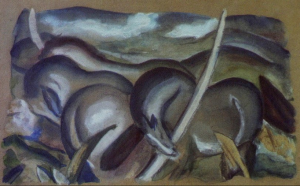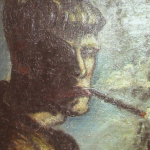A cache of “lost” paintings looted by the Nazis before the Second World War containing some 1,500 works by world-renowned artists including Picasso, Matisse, Chagall and Klee and valued at an estimated €1bn has been found, according to German media reports.
Bavarian customs police discovered the sensational haul in the home of Cornelius Gurlitt, the 80-year-old son of well-known pre-war art dealer Hildebrand Gurlitt. The younger Gurlitt had hoarded the paintings in his Munich apartment for over half a century, according to Germany’s Focus magazine.
(The Independent, November 9, 2013)
 As sensational as this report is, what I find most interesting is that German authorities discovered these paintings almost two years ago (in February 2011).
As sensational as this report is, what I find most interesting is that German authorities discovered these paintings almost two years ago (in February 2011).
Because this raises the question: why is this art find of the century just coming to light?
Color me cynical, but I think it has everything to do with U.S. and UK spy agencies doing all they can to deflect attention from the public shaming they’re experiencing as a result of Edward Snowden’s NSA leaks.
After all, if these agencies are as all-knowing as Snowden would have us believe, surely they not only knew about this Nazi art find, but were also monitoring what German authorities were doing with it. No?
 More to the point, what better way to knock the Germans off their high horse about Americans and Britons spying on them than to plant a media story that forces these Germans to atone, yet again, for Nazi war crimes?
More to the point, what better way to knock the Germans off their high horse about Americans and Britons spying on them than to plant a media story that forces these Germans to atone, yet again, for Nazi war crimes?
And, just as critical acclaim and cash-generating scoops motivated the Washington Post and (London) Guardian to publish Snowden’s leaks — their respective country’s national security and reputation be damned, Focus magazine would have been similarly motivated to publish tips about this Nazi art find.
The U.S. Holocaust Memorial Museum estimates the Nazis seized about 16,000 works of art in all.
(BBC, November 3, 2013)
Frankly, if they were not forced to come clean about these looted paintings, one wonders how long German authorities would have kept this find a national secret: another 10, 20, 50 years…?
Stuart Eizenstat, a former US ambassador to the EU, told the BBC that time was running out, and the details of the artworks should be published.
‘Victims of the Holocaust are aging, even the families of those who did not survive are of an age,’ he said. ‘[T]he longer one goes … the more difficult it is for people to prepare potential claims… Justice delayed is justice denied.’
(BBC, November 5, 2013)
 Now the Germans find themselves in the untenable position of having to explain why they were compounding the horrors of the Holocaust by appearing so lackadaisical about returning these Nazi-looted paintings to their rightful (and likely all-Jewish) owners in a timely manner.
Now the Germans find themselves in the untenable position of having to explain why they were compounding the horrors of the Holocaust by appearing so lackadaisical about returning these Nazi-looted paintings to their rightful (and likely all-Jewish) owners in a timely manner.
In any event, where the English word “indignation” could fairly describe the prevailing mood among Germans about U.S. and UK spying before this report, the German word “schadenfreude” can fairly describe the prevailing mood among Americans and Britons about this Nazi art find today.
Related commentaries:
I said Putin would hand over Snowden…